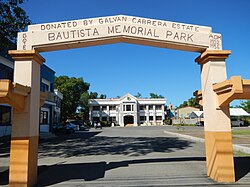Bautista | |
|---|---|
| Municipality of Bautista | |
 Bautista municipal park and auditorium | |
 Map of Pangasinan with Bautista highlighted | |
 Interactive map of Bautista | |
Location within the Philippines | |
| Coordinates: 15°48′37″N120°28′32″E / 15.8103°N 120.4756°E | |
| Country | Philippines |
| Region | Ilocos Region |
| Province | Pangasinan |
| District | 5th district |
| Founded | May 5, 1900 |
| Named after | John the Baptist |
| Barangays | 18 (see Barangays) |
| Government | |
| • Type | Sangguniang Bayan |
| • Mayor | Joseph G. Espino |
| • Vice Mayor | Rosemarie Gacutan |
| • Representative | Ramon V. Guico III |
| • Municipal Council | Members |
| • Electorate | 22,909 voters (2025) |
| Area | |
• Total | 46.33 km2 (17.89 sq mi) |
| Elevation | 21 m (69 ft) |
| Highest elevation | 48 m (157 ft) |
| Lowest elevation | 12 m (39 ft) |
| Population (2024 census) [3] | |
• Total | 35,728 |
| • Density | 771.2/km2 (1,997/sq mi) |
| • Households | 8,478 |
| Economy | |
| • Income class | 4th municipal income class |
| • Poverty incidence | 17.61 |
| • Revenue | ₱ 167.5 million (2022) |
| • Assets | ₱ 277 million (2022) |
| • Expenditure | ₱ 112.9 million (2022) |
| • Liabilities | ₱ 52.45 million (2022) |
| Utilities | |
| • Electricity | Central Pangasinan Electric Cooperative (CENPELCO) |
| • Water | Bayambang Water District (BayWaD) |
| Time zone | UTC+8 (PST) |
| ZIP code | 2424 |
| PSGC | |
| IDD : area code | +63 (0)75 |
| Native languages | Pangasinan Ilocano Tagalog |
Bautista, officially the Municipality of Bautista (Pangasinan : Baley na Bautista; Ilocano : Ili ti Bautista; Tagalog : Bayan ng Bautista; Spanish : Municipio de Bautista), is a municipality in the province of Pangasinan, Philippines. According to the 2024 census, it has a population of 35,728 people. [5]
Contents
- History
- Alcala March to Righteousness
- Geography
- Barangays
- Climate
- Demographics
- Economy
- Government
- Local government
- Municipal seal
- Elected officials
- Tourism
- 1723 Parish Church of St. John the Baptist
- Education
- Primary and elementary schools
- Secondary schools
- References
- Sources
- External links
It is called "The Walis Tambo (broom) Capital of Pangasinan" [6] and honored as the "Lupang Hinirang". [7]




